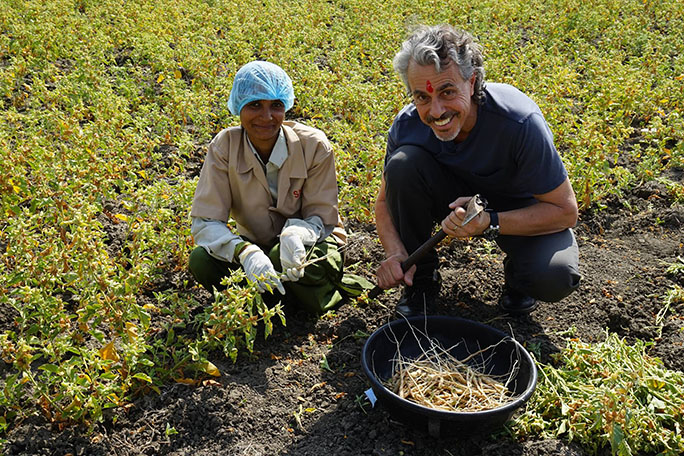Harvesting Ashwagandha in India, South of Kota.
In a certified-organic field in Ramganj Mandi, India, the soil is arid and hasn’t seen water in months. This is exactly how the prolific crop growing there likes it best. Ashwagandha (Withania somnifera), the jewel in the crown of the 5000-year-old system of Ayurveda – which means science of life – thrives in dry, waterless soil, turning a bright green and flourishing where other plants would wither and die. But now the ashwagandha is yellowing, signaling the commencement of this year’s harvest. Women in the field are hard at work, pulling up whole ashwagandha plants, revealing the roots, which are employed for a plethora of health purposes.
Among the approximately 7,500 plants employed in the world’s most ancient system of health care, Ashwagandha root sits at the top of the pile, in popularity, in benefits, and in status as a health-imbuing herb of inestimable value. It is called a rasayan, a life-extender, and is revered. The root and its extracts, rich in a group of novel natural compounds called withanolides, also demonstrate a high degree of safety. One Indian medical doctor said ashwagandha is the one plant that he can give to anyone, in any condition, without concern.
In the Indian Materia Medica, ashwagandha is listed as a tonic, an aphrodisiac, and strength-giving, and is purportedly useful for all cases of debility, nervous exhaustion, and low energy, brain fog, and loss of strength. The plant also enjoys use as a topical aid for the relief of a variety of skin disorders, and applied as a paste to the eyes to treat vision disorders. In ancient texts, Ayurvedic scholars recommend cooking ashwagandha root in fatty milk, no doubt to efficiently extract the resinous and fatty compounds in the root.
But we are a long way from the days of boiling pots of buffalo milk infused with ashwagandha root. Today the herb is extracted using high-tech methods developed by the pharmaceutical and chemical industries, transforming an ancient health aid into a standardized extract used in tablets and capsules, pastes and drinks. At the same time, human clinical studies continue to drive ashwagandha forward in the global health market as a superb adaptogen, an elite botanical that enhances energy, endurance, stamina, and various paramaters of mental function, while reducing stress hormones in the blood and promoting a healthy night’s sleep.
One 2015 study of ashwagandha root extract focused on cardiorespiratory endurance in 50 healthy, athletic adults. A group that took 600 milligrams of ashwagandha root extract daily and a group that received a placebo were followed and tested over a period of 12 weeks, for overall endurance and oxygen consumption during exertion. The ashwagandha group scored higher in endurance and oxygen efficiency than those who took the placebo.
A remarkable 2015 pilot study of women’s sexual function found that among 50 women, those who took ashwagandha root extract experienced improved sexual function, easier arousal, easier lubrication, better orgasms, and improved sexual satisfaction overall. While pharmaceutical companies continue to throw themselves at a “female Viagra,” ashwagandha seems to live up to its reputation, checking off all the boxes.
A 2016 study of body weight management followed 52 subjects under chronic stress. Half the group received ashwagandha root extract and half received a placebo. Over 8 weeks both groups were assessed for food cravings, serum cortisol, body weight and body mass index. The ashwagandha group showed improved scores in all categories, while the placebo group did not, suggesting that ashwagandha may be beneficial in a weight management program.
Lastly, a 2017 study of 50 adults examined the safety and efficacy of ashwagandha in memory improvement and cognitive function. While the placebo group showed no particular improvement in cognitive function, the ashwagandha group tested better in immediate and general memory, improved executive function, attention and information processing speed.
At the National Institute of Ayurveda in Jaipur, professor Sanjeev Sharma explained the many ways that ashwagandha is used in natural medicine today. At an eye clinic , the root is applied as a topical treatment for glaucoma, while at another ashwagandha extract is mixed with oil and massaged deeply into tissue to alleviate nerve problems. We see voucher samples of the root in the herbarium, and watch capsules of ashwagandha root being produced in the institute pharmacy. At the National Institute of Ayurveda, researchers bridge a system that has its origins in antiquity, while employing modern scientific methods.
Ashwagandha root, which uses date back thousands of years, is getting a boost from human clinical studies conducted today. At the meeting of antiquity and modernity, ashwagandha is poised to become broadly known, because it meets many of today’s needs, from reduced stress to enhanced vitality and sharper mental function. Indeed, this ancient root is right for the modern world.


